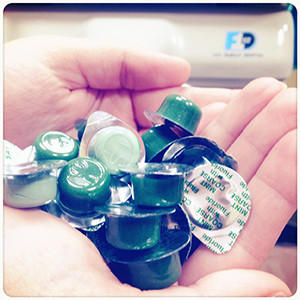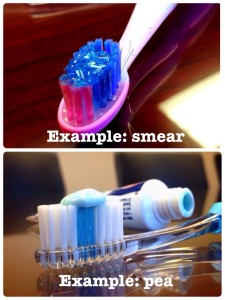 Today’s guest blogger is Dr. Mohamed “Mo”Pezeshk. Dr. Pezeshk is a general dentist who enjoys seeing children and families, and also likes to help us stay on top of emerging trends in the dental field.
Today’s guest blogger is Dr. Mohamed “Mo”Pezeshk. Dr. Pezeshk is a general dentist who enjoys seeing children and families, and also likes to help us stay on top of emerging trends in the dental field.
Oil Pulling
 You may have heard about the trend called “Oil Pulling.” This concept has been around for awhile – oh, say, the past 1,000 years, but recently been revived and gone viral. “Oil Pulling” means swishing with coconut oil or similar cold-pressed oil for about 20 minutes per day. Various studies of oil pulling state that different oils can have many positive results, including whiter teeth, fresher breath, and also provide a variety of other health benefits from weight loss to detoxification and removal of impurities in the body. Today we’ll focus on coconut oil.
You may have heard about the trend called “Oil Pulling.” This concept has been around for awhile – oh, say, the past 1,000 years, but recently been revived and gone viral. “Oil Pulling” means swishing with coconut oil or similar cold-pressed oil for about 20 minutes per day. Various studies of oil pulling state that different oils can have many positive results, including whiter teeth, fresher breath, and also provide a variety of other health benefits from weight loss to detoxification and removal of impurities in the body. Today we’ll focus on coconut oil.
The Pros: Coconut oil is known through scientific research to have antibacterial and antimicrobial properties, meaning they can help to fight off germs and bacteria. Coconut oil is on the affordable end of many other health and beauty trends and products out there. It is a natural plant product, with no chemicals or preservatives. In addition, coconut oil has myriad other uses: as a natural body moisturizer or deep conditioner for hair, replacing vegetable oil in cooking and baking for a healthier alternative, boosting a green smoothie, or simply replacing the butter on your toast.
The Cons: 20 minutes can be a very long time to swish something around in your mouth. For those of us that have a hard time finding the few minutes it takes to brush and floss properly, this may not be a realistic expectation. Also, coconut oil tastes like, well, coconut. If you don’t like the flavor, this may not be for you.
Our Opinion: Pull away! Of course this is provided that your oil pulling routine does not replace flossing, and brushing for 2 minutes, twice per day. Â The friction from brushing and especially flossing are essential steps to help to dislodge bacteria and plaque from the surfaces of your teeth. The most important part of oral hygiene home care is keeping up with the routine. If you’ve tried oil pulling or have made it a part of your daily routine, we’d love for you to tell us what you think.
Amalgam Fillings & Mercury
 Amalgam is most commonly referred to as “metal” or “silver” fillings. In early March 2014, a lawsuit was filed against the FDA challenging the agency’s stance on the safety of elemental mercury. We will be keeping track of the progress of this suit as well as related rulings and findings, and will keep you up to date on key information.
Amalgam is most commonly referred to as “metal” or “silver” fillings. In early March 2014, a lawsuit was filed against the FDA challenging the agency’s stance on the safety of elemental mercury. We will be keeping track of the progress of this suit as well as related rulings and findings, and will keep you up to date on key information.
1st Family Dental does not use amalgam material for fillings and dental restorations. Instead, we use composite resin material at all of our locations for fillings and restorations. We made this choice because we believe composite material, also known as “white” or “tooth colored” fillings, to be an effective treatment option for our patients. Composite material is also more natural looking than amalgam. We also made this choice because while we follow the guidelines provided by regulatory bodies such as the FDA, we always go the extra mile to make sure all of our patients feel comfortable with our clinical practices.
Replacing Fillings & Regular Checkups: 1st Family Dental recommends only replacing fillings of any kind when there is an issue such as wear, decay, pain, cracking or breaking of the tooth or filling. If you notice any of the issues listed above, we recommend you see your dentist as soon as possible for an exam. Tiny cracks and wear in fillings can often be detected during regular exams and x-rays at a dental checkup. We recommend dental health checkups every 6 months. If the dentist notices any issues with your existing fillings, he or she will discuss their findings with you as well as provide you with treatment options.
Fluoride
 Fluoride is another hot topic in the news. There are claims and concerns across the Internet about Fluoride and potential safety or related health issues including certain types of cancer, autism and attention deficit disorder. In some cases, studies have not conclusively identified a clear correlation between fluoride and these health issues, and in others, connections have been made, usually at levels already known to be toxic.
Fluoride is another hot topic in the news. There are claims and concerns across the Internet about Fluoride and potential safety or related health issues including certain types of cancer, autism and attention deficit disorder. In some cases, studies have not conclusively identified a clear correlation between fluoride and these health issues, and in others, connections have been made, usually at levels already known to be toxic.
What We Recommend: We recommend the supervised use of fluoride toothpaste for children ages 2 and older and adult patients, at safe and recommended levels. Fluoride treatment for children is a standard practice at 1st Family Dental during regular cleaning visits. However, our doctors and staff are more than happy to omit fluoride treatment if requested by the parent or guardian.
 Home oral health care routines that include flossing, and brushing for two minutes, twice per day, in combination with regular professional dental cleanings, are the best way to prevent cavities in both adults and children. There are an increasing number of options of fluoride-free and natural toothpastes. Regardless of the type of toothpaste you choose, children should always be closely supervised, and the proper amount of toothpaste should be used.
Home oral health care routines that include flossing, and brushing for two minutes, twice per day, in combination with regular professional dental cleanings, are the best way to prevent cavities in both adults and children. There are an increasing number of options of fluoride-free and natural toothpastes. Regardless of the type of toothpaste you choose, children should always be closely supervised, and the proper amount of toothpaste should be used.
As always, we welcome your comments and suggestions. Feel free to post a response below, or send us an email anytime at email@1fd.org.



12 Comments
Leave your reply.